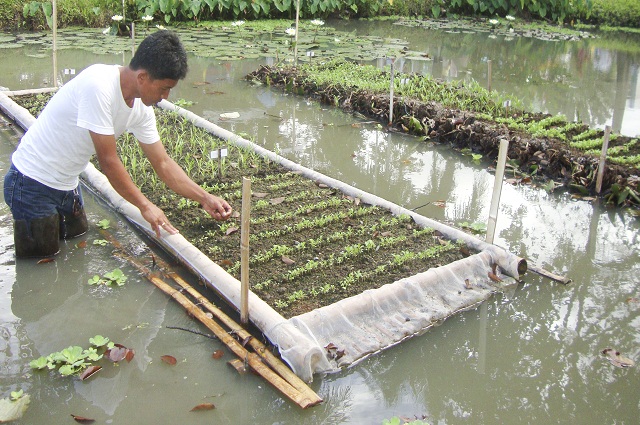
One of the recommended ways for farmers to adapt to the effects of La Niña is to establish floating gardens in their water-soaked fields.
Despite reports on La Niña expecting to last until March from the Philippine Atmospheric, Geophysical and Astronomical Services Administration (PAGASA), climate change experts from PhilRice advise farmers to remain calm as the effects may not be detrimental but at the same time urge them to be always prepared.
“The effects of La Niña vary around the world. In the Philippines, it brings more rains while in other countries, the usual effect can also be drought. Local farmers need not panic as what we might be experiencing until March are just slight effects of La Niña, after that everything will return to the neutral condition,” says Dr. Jasper G. Tallada, climate change expert and supervising science research specialist from PhilRice’s Rice Engineering and Mechanization Division (REMD).
Tallada has emphasized that while there is no early sign of detrimental effects of La Niña, it is still good to be prepared and alert. Hence, he advises farmers to regularly check updates on La Niña and other extreme weather conditions that can affect their rice farming. He also recommends them to adopt some practices that will help them prepare for the effects of La Niña.
“We encourage farmers to use submergence-tolerant varieties or those that can still survive despite being soaked in water for days. These varieties include PSB Rc 68 (Sacobia) and NSIC Rc 194 (Submarino 1). They should also plan their planting schedule very well to avoid torrential rains and strong winds that can cause damages to crops,” explains Dr. Ricardo F. Orge, lead of the PhilRice’s Climate Resiliency for Enhanced Agricultural Trade and Efficiency for Rice (CREATE Rice) Program.
According to these experts, farmers should repair drainage canals, dykes, and ensure an effective water management system in the field to avoid pest infestation and diseases that are prevalent during La Niña. Farmers are also encouraged to plant trees around their fields that can serve as wind breakers for crops during strong winds.
Meanwhile, Orge and Tallada have also highlighted the effectiveness of using mechanical dryers in drying the crops, the establishment of floating gardens for water-soaked areas, and the use of small farm reservoir to store rainwater that can be used by farmers in the next planting seasons.
“The bottomline is that we should always be informed about the changes in our weather. We can check for updates from PAGASA and the National Disaster Risk Reduction & Management Council (NDRRMC),” Tallada concludes.




